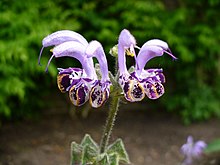| Salvia indica | |
|---|---|

| |
| Scientific classification | |
| Kingdom: | Plantae |
| Clade: | Tracheophytes |
| Clade: | Angiosperms |
| Clade: | Eudicots |
| Clade: | Asterids |
| Order: | Lamiales |
| Family: | Lamiaceae |
| Genus: | Salvia |
| Species: | S. indica
|
| Binomial name | |
| Salvia indica | |
Salvia indica (pied sage or two-lip spotted sage) is a species of herbaceous perennial plant belonging to the family Lamiaceae. It is native to a wide region of Western Asia that includes Israel, Iraq, Iran and Turkey. It was first described by the taxonomist Carl Linnaeus in 1753.[1][2][3] It is unknown why he gave it the specific epithet indica, since the plant is not from India. While Salvia indica is classified as a herbaceous perennial, in cultivation individual plants often live no longer than two years.[4]
- ^ "Salvia indica". International Plant Names Index (IPNI). Royal Botanic Gardens, Kew; Harvard University Herbaria & Libraries; Australian National Botanic Gardens. 29 January 2009.
- ^ "Salvia indica". International Plant Names Index (IPNI). Royal Botanic Gardens, Kew; Harvard University Herbaria & Libraries; Australian National Botanic Gardens. 8 June 2023.
- ^ "Salvia indica". International Plant Names Index (IPNI). Royal Botanic Gardens, Kew; Harvard University Herbaria & Libraries; Australian National Botanic Gardens. 8 June 2023.
- ^ Clebsch, Betsy; Barner, Carol D. (2003). The New Book of Salvias. Timber Press. p. 149. ISBN 978-0-88192-560-9.